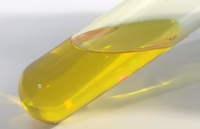Vanadium oxytrichloride
The reaction proceeds near 600 °C:[5] Heating an intimate (well-blended with tiny particles) mixture of V2O5, chlorine, and carbon at 200–400 °C also gives VOCl3.In this case the carbon serves as a deoxygenation agent akin to its use in the chloride process for the manufacturing of TiCl4 from TiO2.Vanadium(III) oxide can also be used as a precursor:[2] A more typical laboratory synthesis involves the chlorination of V2O5 using SOCl2.[6] VOCl3 quickly hydrolyzes resulting in vanadium pentoxide and hydrochloric acid.VOCl3 is strongly Lewis acidic, as demonstrated by its tendency to form adducts with various bases such as acetonitrile and amines.


IUPAC nameCAS NumberChemSpiderECHA InfoCardEC NumberPubChemRTECS numberUN numberCompTox DashboardSMILESChemical formulaMolar massDensityMelting pointBoiling pointSolubility in waterVapor pressureMolecular shapeGHS labellingPictogramsHazard statementsPrecautionary statementsNFPA 704Vanadium(V) oxytrifluorideVanadium(V) oxidestandard stateinorganic compoundformulaoxidizing agentreagentorganic synthesisvanadium tetrachloridediamagnetictetrahedralbenzenehexane51V NMR spectroscopychlorinationcarbondeoxygenationchloride processvanadium pentoxidehydrochloric acidalkoxidesvanadyl isopropoxidevanadium oxydichlorideLewis acidicadductsacetonitrileaminesphenolsanisolesVanadium compoundsV(CO)6V2(SO4)3V(C9H11)3V(S2)2VO(C5H7O2)2NH4VO3VO(ClO4)3VO(NO3)3